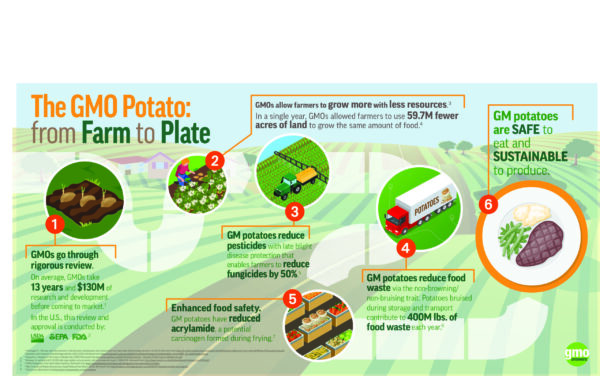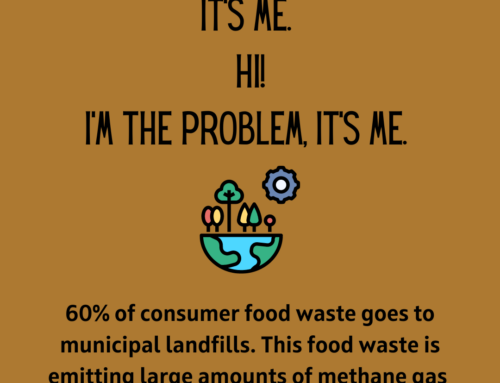Are you concerned about what’s in your food?
Nature is full of chemicals. Even the “chemicals” in your food are mostly derived from nature (from either plants or animals). I’ve written about food safety and food technology in many different ways over the past several years. In addition to food safety in the kitchen, I’ve covered both crop (plant) technology and animal agricultural practices.
The progress that’s been made in food technology over my career has fascinated me. Bioengineering food can alter the growth of a crop, improve disease resistance, or modify product quality. It often reduces the need for both pesticides and herbicides in a crop. Modifying crops can also help reduce food waste. When crops (non-browning apples or non-bruising potatoes for instance) have less imperfection, taste better and last longer, there’s less waste. My hope is that by the year 2025, consumers will become more comfortable with the technology used to advance our food or environment.

One example of how a biotech crop is researched, developed, and brought to market.
Food Labeling
Consumers want to know that their food supply is safe. Food labels have become increasingly challenging to interpret however. In my opinion, the ingredient label may be the most useful and least confusing aspect of the label. The Nutrition Facts panel and ingredient list provide information about nutrition per serving and the ingredients used in the food. Health claims can also appear on a food label but they must meet the regulations of the FDA.
Consumers also want additional information (where a food or ingredient is sourced, other ingredient details). Some say the Smart Label could be the best way to provide this type of information. I agree that as food technology moves forward, using this type of labeling technology (QR code) may be one way to learn more about a food. However it’s unlikely that consumers will scan every food and read through the information before it’s thrown it into the cart. We’ll need multiple ways to communicate.
Communicating About the Integrity of Food
I recently moderated a panel of experts about consumer concerns about biotech in food for the digital BIO Impact conference. We discussed consumer issues surrounding food safety, food labeling and the agencies that regulate ingredients. In addition to the value, price, and nutrition from food, consumers have a right to know where their food comes from and what’s in it. Labeling foods that may include biotech ingredients is not so simple however.

It’s unlikely that all consumers are interested in how the scientific advancements of food and crops work. Yet consumers will want transparency from food companies. To build trust, information about the biological and technological tools that farmer use will also have to be shared.
Transparency of ingredients is one thing, but maybe consumers also should know what the benefits of an ingredient are?
The challenge however, is communicating all of this information so consumers can understand it. Dietitians can help in this conversation by sharing the science that supports the advancements in biotechnology that are becoming rapidly… Click To Tweet
It’s not just simply about the food on supermarket shelves. The behind the scenes progress that brings food to the shelves is also important. Consumer trust in industry must improve with continued transparency in communicating the science within the Agriculture and biotech space. Brilliant scientists fill these large companies and industries. These men and women are continuously conducting research that fuels the development of new ideas which bring more food to our tables in sustainable ways, all over the globe. If consumers lack trust in these advances, both nutrition and our environment will suffer.
Communicating about Food and Biotech
The biotech space spans advances in food, energy, and health in ways that we could only have imagined just 15 years ago. It’s moving fast, which makes it really important for health and science communicators to stay abreast of advances and translate the science and technology to consumers. Here are some tips for being an effective science communicator:
- Be honest and truthful
- Use the body of evidence to create messages that resonate
- Help consumers recognize that there are always both pros and the cons to advancements or new ingredients or food modality
- Help consumers think forward and understand how products benefit both them and the environment
- Understand that transitions are difficult, and the future of food is going to need to transition quickly to meet the ever-changing climate challenges as well as the growing population
I challenge you to begin to think about this progress with an open mind. Advances in crop and animal agriculture support both people and the planet.
Further reading
Here is just a small glimpse of the kind of companies that work in this biotechnology space, as well as consumer groups that keep watch.
- Companies like Syngenta work on crop development and plant science to advance crops.
- Companies like Bayer that advance crop farming will help agriculture use resources in the most sustainable and productive ways.
- Digital farming will continue to grow as we work to use less resources and provide specific applications only where needed.
- Check out companies like Genus, who work to advance animal agriculture in a safe and sustainable way.
- Fertilizers are important to growing productive crops, but impact the carbon footprint. Nitrogen is key, and sustainable ways to deliver it are important.
- Center for Science in the public Interest has long been a watchdog for consumer products. They now also follow the biotech advancements of food.
- The National Consumers League has a long history of looking out for consumers.
- The Consumer Federations of America advocates for a safer, healthier, and more affordable food supply.




